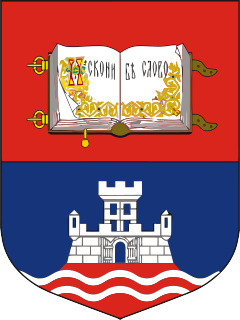The Royal College of Science was a higher education institution located in South Kensington; it was a constituent college of Imperial College London from 1907 until it was wholly absorbed by Imperial in 2002. Alumni include H. G. Wells and Brian May and are distinguishable by the letters ARCS(Associate of the Royal College of Science) after their name. Organisations linked with the college include the Royal College of Science Union and the Royal College of Science Association.

Osijek is the fourth largest city in Croatia with a population of 108,048 in 2011. It is the largest city and the economic and cultural centre of the eastern Croatian region of Slavonia, as well as the administrative centre of Osijek-Baranja County. Osijek is located on the right bank of the river Drava, 25 kilometres (16 mi) upstream of its confluence with the Danube, at an elevation of 94 metres (308 ft).
CARNET is the national research and education network of Croatia. It is funded from the government budget and it operates from offices in Zagreb and five other cities.

The University of Zagreb is the largest Croatian university and the oldest continuously operating university in the area covering Central Europe south of Vienna and all of Southeastern Europe.

The University of Belgrade is a public university in Serbia. It is the oldest and largest university in Serbia, and one of the most important educational and research centers in Southeast Europe.

King Mongkut's Institute of Technology Ladkrabang is a research and educational institution in Thailand. It is in the city of It is approximately 30 km east of the center of Bangkok in Lat Krabang District, Bangkok, Thailand, and has seven faculties: engineering, architecture, agricultural technology, science, industrial education, agricultural industry, information technology, and liberal arts.

University Putra Malaysia is recognised by the independent government assessments as one of Malaysia's leading research universities offering undergraduate and postgraduate courses with a focus on agricultural sciences and its related fields. Founded in 1931 as the School of Agriculture, UPM's main campus is in Serdang, Selangor. It was formerly known as Universiti Pertanian Malaysia or the Agricultural University of Malaysia. Now, UPM offers a wide range of undergraduate and postgraduate programmes in most fields such as science, engineering, medicine, veterinary medicine, business and social science.It was ranked as the 159th best university in the world in 2020 by Quacquarelli Symonds. and it was ranked 34th in Best Asian Universities and the 2nd best university in Malaysia.

Urmia University is a public university in West Azerbaijan province, Iran. The main campus of Urmia University is in Nazlu, in the vicinity of Urmia. It has six campuses, seven schools, more than 14,000 students, and several exclusive research centers including Microelectronic, Antenna and Microwave Laboratory, Nanotechnology, MEMS, and Artemia. Urmia University also has two satellite campuses in Khoy and Miyandoab city. Nazlu campus of Urmia University is the biggest university campus in size in the northwest of Iran. Urmia University is ranked as one of Iran's "Grade A" universities by Ministry of Science, Research and Technology.

Wrocław University of Environmental and Life Sciences – a public higher education institution founded in 1951. One of the best career-oriented universities in Poland, it ranks as the country’s second biggest patent licensor as well as the second best life-sciences and agricultural university.

The University of Agriculture (UAF) is a public research university in Faisalabad, Pakistan. It is ranked 4th in Pakistan and 1st in the field of Agriculture and Veterinary Sciences by HEC Ranking 2019. It was also ranked at No.127 in life Science and Agricultur Science. The employability ranking by Pakistan made this institution highly reputable. The university came among top 5 institutions of Pakistan in research power. Muhammad Ashraf is serving as Vice Chancellor of the University.

The University of Split is a university located in Split, Croatia. It was founded in 1974. and is organized in 13 faculties and 124 faculty programmes. As of 2009, a total of approximately 40,000 students have graduated, and a total of 337 doctoral degrees have been awarded.
The University of Peradeniya, in Sri Lanka, is composed of nine undergraduate faculties of study. These faculties contain 79 departments in total. In addition, the university has two postgraduate institutions and six affiliated centres.
The Faculty of Agricultural Science and Food in Skopje is a part of Ss. Cyril and Methodius University of Skopje. The faculty is located in the eastern part of the city Skopje on campus with other departments of biolocical and biotechnological science:Faculty of Mathematics and Natural Sciences, Faculty of Veterinary Medicine, University Hospital for Veterinary Medicine, Veterinary Institute, Institute of Agriculture and Faculty of Forestry. Campus is 2 km away from the Rector of SS. Cyril and Methodius, and within the campus is located dormitory Stiv Naumov ". The faculty is equipped with a net usable building area of 7465m2, which houses six amphitheaters, 26 lecture, 28 laboratories, 143 offices, library and reading room with an area of 270 m2 and a student café with an area of 180m2. The Dean from 2009 is Prof.Dr. Dragi Dimitrievski Ph.D.
The Faculty of Chemical Engineering and Technology is a faculty of the University of Zagreb. The Faculty is regarded as the largest faculty and the leading educational and research institution in the field of chemical engineering in Croatia.
The Faculty of Electrical Engineering in Osijek is a faculty (Croatian fakultet, meaning college or department of the Josip Juraj Strossmayer University of Osijek.
The Faculty of Food Technology is a faculty of the University of Osijek.
The School of Medicine is a faculty of the University of Osijek.

The Eszterházy Károly University of Applied Sciences was founded in 1774 in Eger. In 1989 it was renamed after its founder Bishop Károly Eszterházy. Number of students is 8602.
Ignatius Ajuru University of Education is a Nigerian university based in Rumuolumeni Port Harcourt, Rivers State. The first Vice-Chancellor of the university in 2014 was Rosemund Dienye Green-Osahogulu. The present Vice-Chancellor is Ozo-Mekuri Ndimele.















